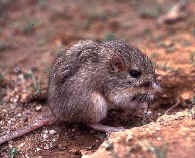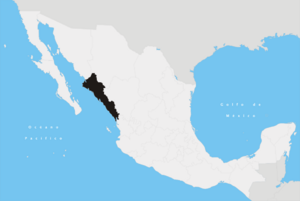Sinaloan pocket mouse facts for kids
Quick facts for kids Sinaloan pocket mouse |
|
|---|---|
 |
|
| This is a Desert pocket mouse, a close relative of the Sinaloan pocket mouse. | |
| Conservation status | |
| Scientific classification | |
| Genus: |
Chaetodipus
|
| Species: |
pernix
|
The Sinaloan pocket mouse (Chaetodipus pernix) is a small mouse found only in Mexico. It is one of 17 types of pocket mice. There are two main groups, or subspecies, of this mouse: C. p. pernix and C. p. rostratus.
This tiny mouse lives among bushes and can have many different fur colors.
Contents
Where They Live and Their Home
Sinaloan pocket mice mostly live along the coast of Sinaloa state in Mexico. This area stretches from southern Sonora to northern Nayarit. Their home is usually filled with small trees, bushes, and cacti.
You can find these mice on sandy soil. They often live under low bushes or in thick areas of vines and grasses. Unlike their close relative, the rock pocket mouse, their homes do not have rocks.
What They Look Like
The Sinaloan pocket mouse is one of the smallest pocket mice. It is less than 200 millimeters (about 8 inches) long from nose to tail tip. They have a narrow head with a long nose and medium-sized ears.
Their tail is thin and has little hair. It is also longer than their body. Their fur color can change, but it is usually yellowish-brown. It is always darker on their back and lighter on their sides and belly. These mice eat mostly grains and seeds. A mother mouse usually has about seven babies at a time.
Why Their Fur Color Varies
The fur color of pocket mice can be very different, even among mice from the same family. This is because of their genotype, which is like their unique genetic code. Many things in their environment can affect what fur color helps them survive best. Different fur colors give pocket mice an advantage for two main reasons: hiding and staying cool.
Hiding from Predators
Being able to hide from animals that want to eat them, like owls, is very important for pocket mice. This is called Crypsis. Pocket mice use two main ways to hide with their fur color: camouflage and countershading.
- Camouflage: This means an animal's color helps it blend in with its surroundings. For example, Sinaloan pocket mice usually have yellowish-brown fur with some black hairs. This helps them hide in the sandy areas under bushes where they live. In contrast, the Rock pocket mouse often has gray or black fur because it lives among dark rocks. Mice whose fur color does not match their environment are easier for predators to spot.
- Countershading: This is another type of camouflage. It means an animal's fur is darker on its back and lighter on its belly. Sinaloan pocket mice almost always have a lighter belly and sides compared to their darker back. This helps them hide from predators, especially owls flying overhead. In sunny deserts, countershading helps the mouse's shadow look less obvious. Mice with shadows that are easy to see are more likely to be caught by owls.
Staying Cool in the Desert
Fur color can also help pocket mice control their body temperature. In hot, sunny places, light-colored fur is helpful. It reflects sunlight, which helps the mouse stay cooler. Dark fur would absorb more sunlight, making the mouse hotter. If a mouse gets too hot, it has to use more energy to cool down. Light-colored fur helps them save energy, which is a big advantage in the desert.
Genes and Fur Color
The different fur colors in pocket mice are mostly controlled by their genes. Genes are like instructions inside every living thing that tell the body what to do. In mice, certain genes tell their cells to make different types of color. These differences in genes mean that some mice will have lighter fur, and others will have darker fur.
Over time, mice that have the best fur color for their environment are more likely to survive and have babies. This means that mice in sandy, sunny places will likely have light, yellowish-brown fur. Mice living on dark rocks in less sunny areas might have darker gray or black fur. This is how different fur colors have developed in pocket mice across different places.



